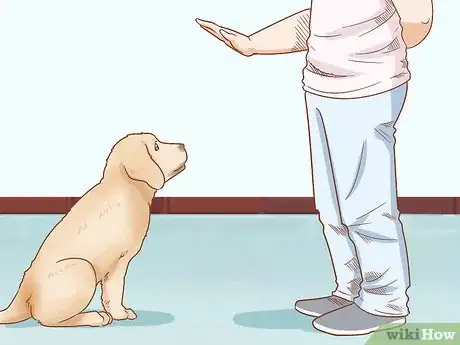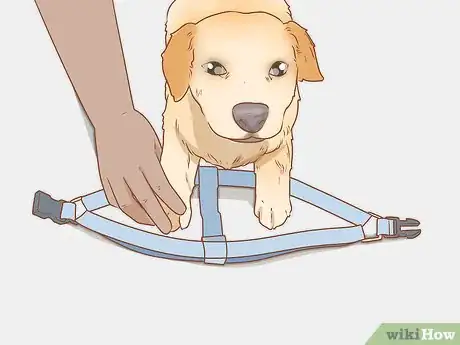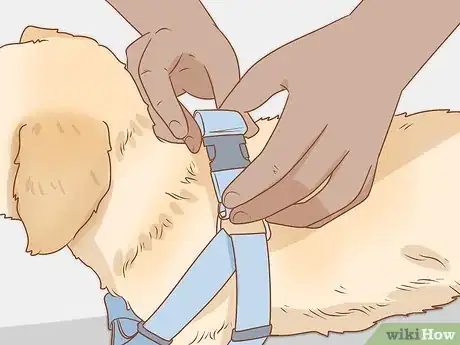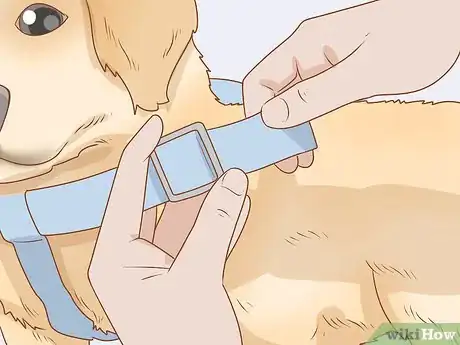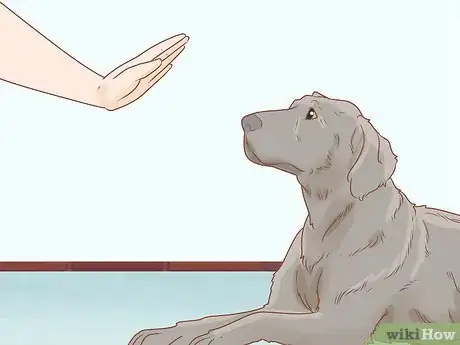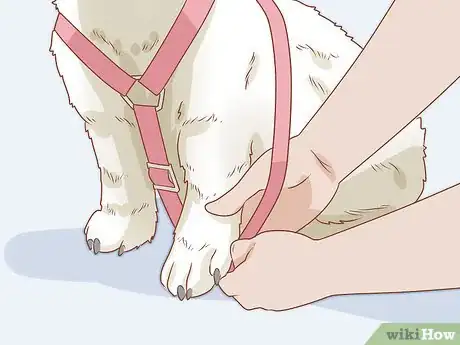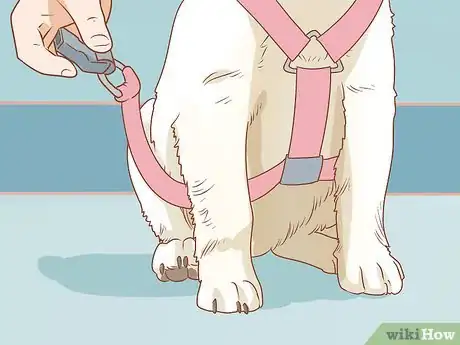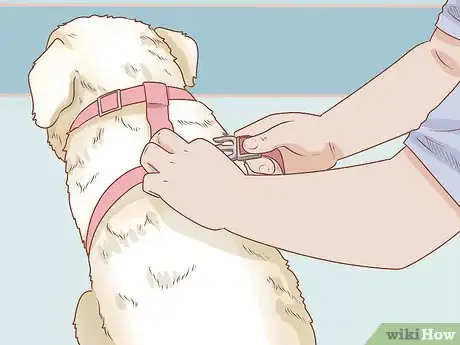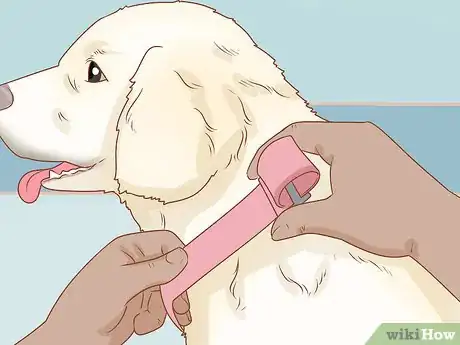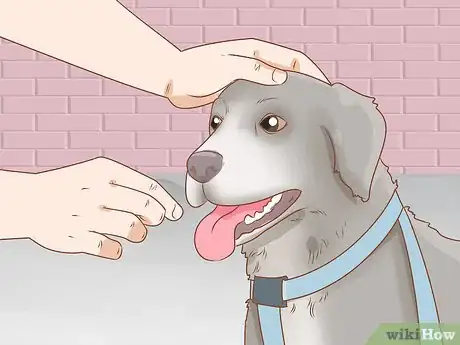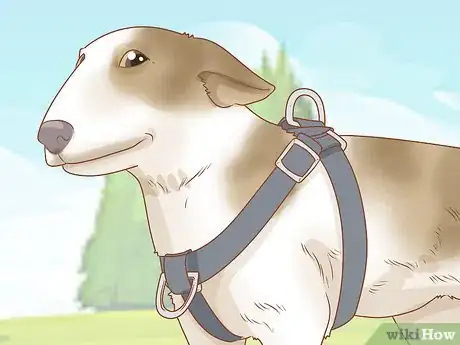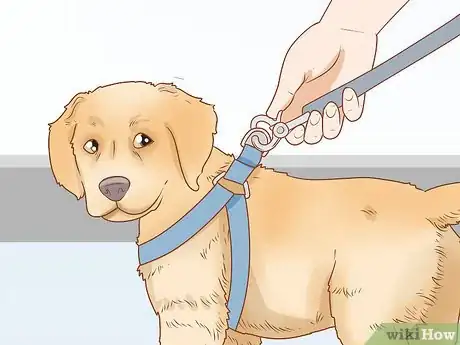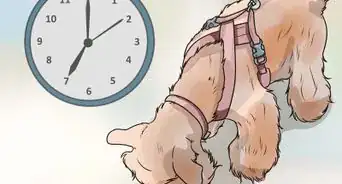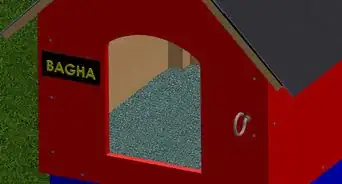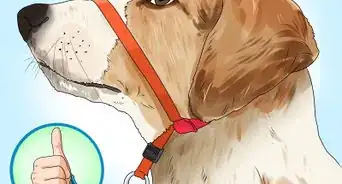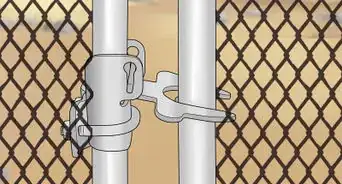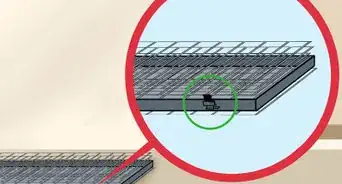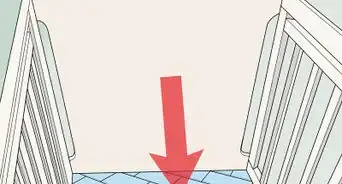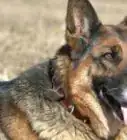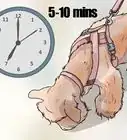This article was co-authored by Beverly Ulbrich and by wikiHow staff writer, Danielle Blinka, MA, MPA. Beverly Ulbrich is a Dog Behaviorist and Trainer and the Founder of The Pooch Coach, a private dog training business based in the San Francisco Bay Area. She is a Certified CGC (Canine Good Citizen) Evaluator by the American Kennel Club and has served on the Board of Directors for the American Humane Association and Rocket Dog Rescue. She has been voted the best private dog trainer in the San Francisco Bay Area 4 times by SF Chronicle and by Bay Woof, and she has won 4 "Top Dog Blog" awards. She has also been featured on TV as a dog behavior expert. Beverly has over 18 years of dog behavior training experience and specializes in dog aggression and anxiety training. She has a Master of Business Administration from Santa Clara University and a BS from Rutgers University.
There are 7 references cited in this article, which can be found at the bottom of the page.
This article has been viewed 233,776 times.
Dog harnesses typically fall into two categories, ones that your dog will step into and ones that you will place on over the dog's head. All harnesses, regardless of how they are put on, allow you to safely walk your dog without putting much pressure on the dog's neck and keeping them from jumping or pulling. At first, your dog's harness might seem confusing and impossible to put on, but it’s easier than it looks! The first step is determining the type of harness it is; once you do that, you can put the harness on and take your dog for a nice, long walk!
Steps
Putting on a Step-In Harness
-
1Place the unbuckled harness on the ground. You need enough space for you and your dog to get behind the harness. The harness should have two leg loops in the front with straps down the middle. Spread out the straps so it will be easier to help the dog into the harness.[1]
- If your harness has a vest or chest cover attached to it, make sure the outside is facing down toward the floor.
-
2Command your dog to "sit" and "stay" behind the harness. This makes it easier to help your dog into the harness.[2] If your dog hasn’t learned “sit” and “stay” commands, you or a partner will need to hold the dog still while you put on the harness. [3]
- If the dog squirms, it’s best to have a partner to help you get it into the harness.
Advertisement -
3Place your dog's front paws into the correct loops on the harness. Pick up the right paw and move it forward into the appropriate loop. After you put the right paw down on the floor, lift the dog's left paw and place it into the other loop.[4]
- Some harnesses label which side is meant for which paw. However, many harnesses are reversible. Check your harness to see which type you have.
-
4Pull the harness up onto your dog. The harness should fit around your dog's body, not around its neck. The loops will settle at the top of the dog’s legs against its belly. Tug the side straps up over the dog’s belly and onto its back.[5]
- The harness may have more than one clip to secure it on the dog. For example, it might have a shoulder clip and lower back clip. You may need to pull up and clip the straps one at a time if this is the case.
-
5Secure the clips on the harness. Slide the two pieces of the clip together. Listen for the “click” that tells you the clip has attached. Tug on the clip to make sure it doesn’t come undone.[6]
- If your harness has more than one clip, attach all of them.
-
6Adjust the harness to fit on your dog. Move the adjustable pieces on the harness until they’re secure on your dog. Make sure the straps aren't loose enough to come off the dog but not so tight that it causes chafing.[7] Next, check that you can fit 2 fingers under the harness straps, which ensures the harness won’t be too tight on your pup.[8]
- Check that the dog can’t easily slip out of the harness. Make sure it won’t easily come down over the dog’s paw or up over its head.
- You will need to adjust the harness every time your dog wears it.
-
7Reward your pup with a treat and praise. This teaches your dog to enjoy putting on its harness. It also makes it easier for you to put on the harness in the future, as your pup will look forward to the treats![9]
Securing an Overhead Harness
-
1Command your dog to “sit” and “stay.” It’s easier to put the harness on the dog if it stands in place. Your dog should be sitting in front of you.[10]
- If your dog isn’t trained to “sit” and “stay,” you or a partner will need to hold the dog still while you put on the harness.
-
2Find the neck hole and slide it over the dog's head. The neck hole should look like a circle that fits over your dog’s head and shoulders. Find the D-ring for the leash, then position it either in the front or the back, depending on where it's supposed to go. Slide the harness over the dog's head and position it low on the dog's shoulder area so it isn't around the neck.[11]
- The neck hole is usually the smallest hole on the harness. The side straps will be attached to the neck hole on each side.
- You want the harness to rest against the dog's body rather than around its neck.
- If your overhead harness has a vest or comfort shield attached, make sure the outside of the fabric is facing away from your dog.
-
3Put one of the dog’s paws into the loop on the harness. Your harness should have a leg loop on one side. Lift the dog’s paw up off the floor and slide it into the loop. Then, put your dog’s paw down on the floor.[12]
- If your harness clips in place on both sides, you’ll need to clip the straps around the first leg. Wrap the two straps around the leg, then clip the buckle.
-
4Loop the remaining strap under your dog’s leg and up toward its back. This will turn the strap into a leg loop. Make sure the strap goes under and behind the dog’s leg, which is important for control.[13]
- Once the harness is on your dog, it will look like both legs are inserted into side loops.
-
5Click the buckle on the dog’s back. The strap that you looped behind the dog’s leg will clip into a buckle on the dog’s back. Push both sides of the buckle together, then listen for the “click.”[14]
- Test the buckle to make sure it’s secure. You should be able to pull up on the buckle without it coming apart.
-
6Fit the harness around your dog using the plastic adjusters. Slide the adjusters to tighten or loosen straps, as necessary. Pull on the straps to check that the neck hole and leg loops aren't loose enough for your dog to get out of them. Then, check that you can put 2 fingers under the straps to ensure it's not too snug.[15]
- You should adjust the harness every time you use it.
- The harness should feel tight against your dog's fur but not pressed against its body.[16]
-
7Give your pup a treat and lots of praise. Putting on the harness should be a pleasant experience for your dog. This teaches it to like putting on its harness, making it easier to outfit the dog for future walks.[17]
Attaching a Leash
-
1Check the position of your leash clip. Basic harnesses have a leash clip in the back, while training or no-pull harnesses usually have a clip in the front. However, you can find harnesses that can be clipped in either the front or the back. The leash clip should look like a D-ring.[18]
- If your harness only has a clip on one side, don’t try to attach the leash on the other side.
-
2Clip the leash on the back of the harness for calm dogs and small dogs. Find the D-ring on the back of your dog’s harness. Open the clasp on the leash, then secure it over the D-ring. A back-clip harness provides a comfortable walking experience for dogs that don’t pull or jump. These harnesses are also safe for little dogs that have small, sensitive necks.[19]
- Back-clip leashes are less likely to get tangled around your dog’s feet.
- If your dog tends to pull, however, a back-clip harness could result in you being drug around like a sled.[20]
-
3Attach the leash on the front to train or control your dog. Find the D-ring on the front center of your dog’s harness, then pull back the clasp on the leash. Place the clasp over the D-ring and attach it. This will allow you to have more control over your dog, especially if it tends to pull or jump. You can determine the position your dog moves and stop it from jumping up.[21]
- Front-clip leashes are more easily tied up in your dog’s legs. Watch your dog to make sure it doesn’t get tripped up or twisted in the leash. If it does, stop and untangle the dog.[22]
Warnings
- A harness that is too tight can hurt your dog. Similarly, a loose harness could allow your pup to slip out, making the harness ineffective.⧼thumbs_response⧽
References
- ↑ https://topdogtips.com/how-to-put-on-a-dog-harness/
- ↑ https://www.petmd.com/dog/training/evr_dg_how-to-properly-put-on-dog-harness
- ↑ https://www.care.com/c/stories/6280/how-to-put-on-a-dog-harness/
- ↑ https://www.care.com/c/stories/6280/how-to-put-on-a-dog-harness/
- ↑ https://topdogtips.com/how-to-put-on-a-dog-harness/
- ↑ https://www.care.com/c/stories/6280/how-to-put-on-a-dog-harness/
- ↑ Beverly Ulbrich. Dog Behaviorist & Trainer. Expert Interview. 30 January 2020.
- ↑ https://www.petmd.com/dog/training/evr_dg_how-to-properly-put-on-dog-harness
- ↑ https://www.petmd.com/dog/training/evr_dg_how-to-properly-put-on-dog-harness
- ↑ https://www.petmd.com/dog/training/evr_dg_how-to-properly-put-on-dog-harness
- ↑ https://topdogtips.com/how-to-put-on-a-dog-harness/
- ↑ https://www.care.com/c/stories/6280/how-to-put-on-a-dog-harness/
- ↑ https://www.care.com/c/stories/6280/how-to-put-on-a-dog-harness/
- ↑ https://www.care.com/c/stories/6280/how-to-put-on-a-dog-harness/
- ↑ https://topdogtips.com/how-to-put-on-a-dog-harness/
- ↑ Beverly Ulbrich. Dog Behaviorist & Trainer. Expert Interview. 30 January 2020.
- ↑ https://www.petmd.com/dog/training/evr_dg_how-to-properly-put-on-dog-harness
- ↑ https://www.petmd.com/dog/training/evr_dg_how-to-properly-put-on-dog-harness
- ↑ https://www.petmd.com/dog/training/evr_dg_how-to-properly-put-on-dog-harness
- ↑ http://www.vetstreet.com/our-pet-experts/harnessing-the-walk-choosing-the-right-harness-for-your-dog
- ↑ https://www.petmd.com/dog/training/evr_dg_how-to-properly-put-on-dog-harness
- ↑ http://www.vetstreet.com/our-pet-experts/harnessing-the-walk-choosing-the-right-harness-for-your-dog?page=2
- ↑ http://www.vetstreet.com/our-pet-experts/harnessing-the-walk-choosing-the-right-harness-for-your-dog?page=3
- ↑ Beverly Ulbrich. Dog Behaviorist & Trainer. Expert Interview. 30 January 2020.
About This Article
To put a step-in harness on your dog, start by laying the harness down on the floor with the straps unbuckled and spread out. If the harness includes a chest cover, position it so it’s flat on the floor with the outside surface facing down. Check that you know which end of the harness goes in front and which goes in back, since this will make it easier for you to put your dog’s feet into the correct loops. Position your dog behind the harness and command it to sit and stay. If your dog doesn’t know how to sit and stay, have another person help you hold the dog in place if possible. Next, guide your dog’s front paws into the correct loops, one at a time. Pull the harness up against your dog’s chest and around its torso, then buckle the straps to secure it in place. If you need to, adjust the straps to tighten or loosen them so they fit your dog better. The straps should be loose enough so that you can fit two fingers between them and your dog’s body, but not so loose that your pup can easily slip out. If you’re using an overhead harness, have your dog sit down facing you. Find the neck hole on the harness and carefully guide it over your dog’s head. Turn the harness so it’s oriented the right way—for instance, if it’s a front-lead harness, check that the D-ring for the leash attachment is in front, over the dog’s chest. If it’s a top-lead harness, the ring should go on top, over your dog’s shoulders. If the harness has a vest or chest-guard, make sure it’s right-side-out. Next, guide your dog’s front paws through the leg loops on either side of the harness, one leg at a time. Pull the straps around your dog’s body and buckle them securely in place. Check to make sure the harness fits your dog firmly but comfortably, and adjust the straps if necessary using the slider buckles. When you’re done, reward your dog with praise and a treat so it will associate the harness with good things. Attach a leash to the D-ring, and you’re ready to take your furry friend for a walk. For tips on how to put an overhead harness on your dog, scroll down!

